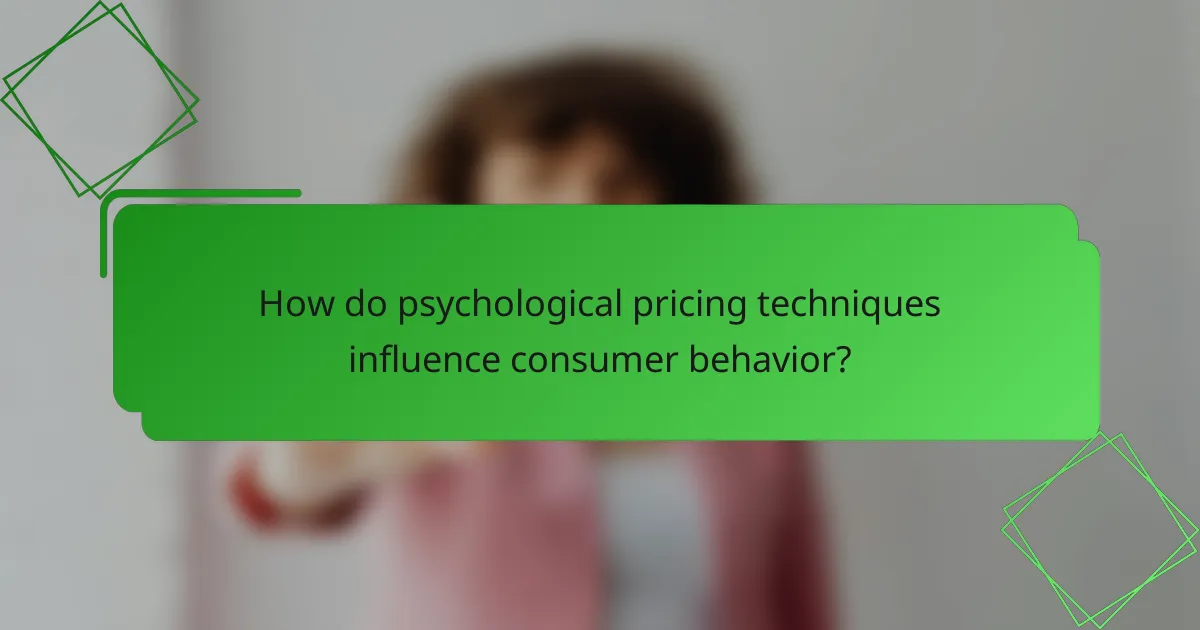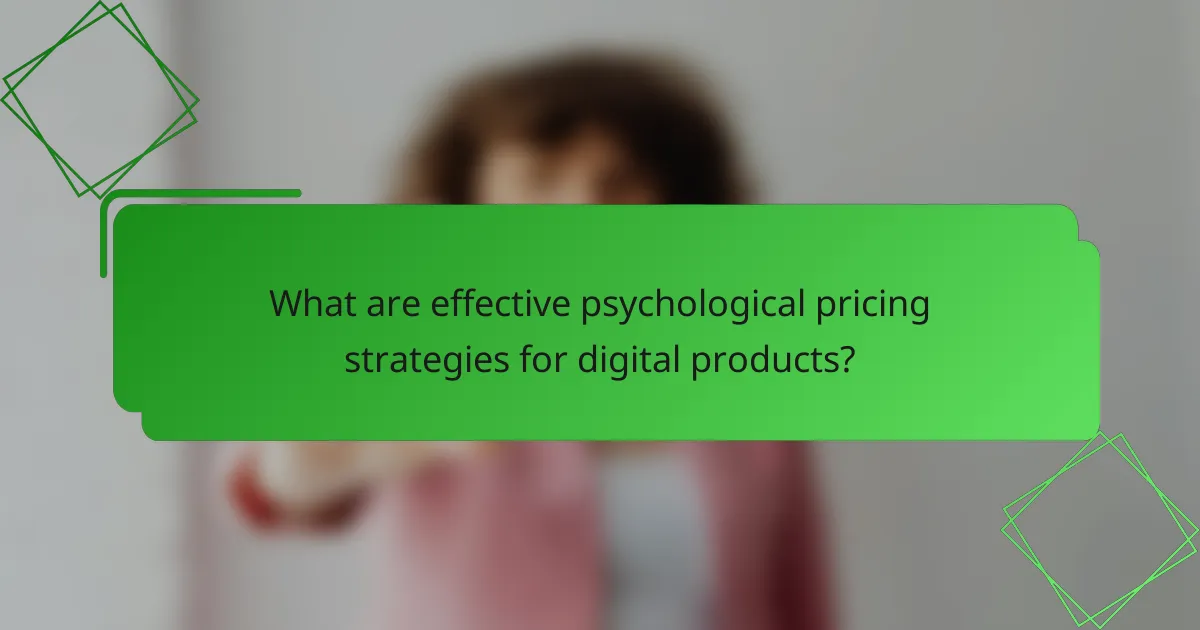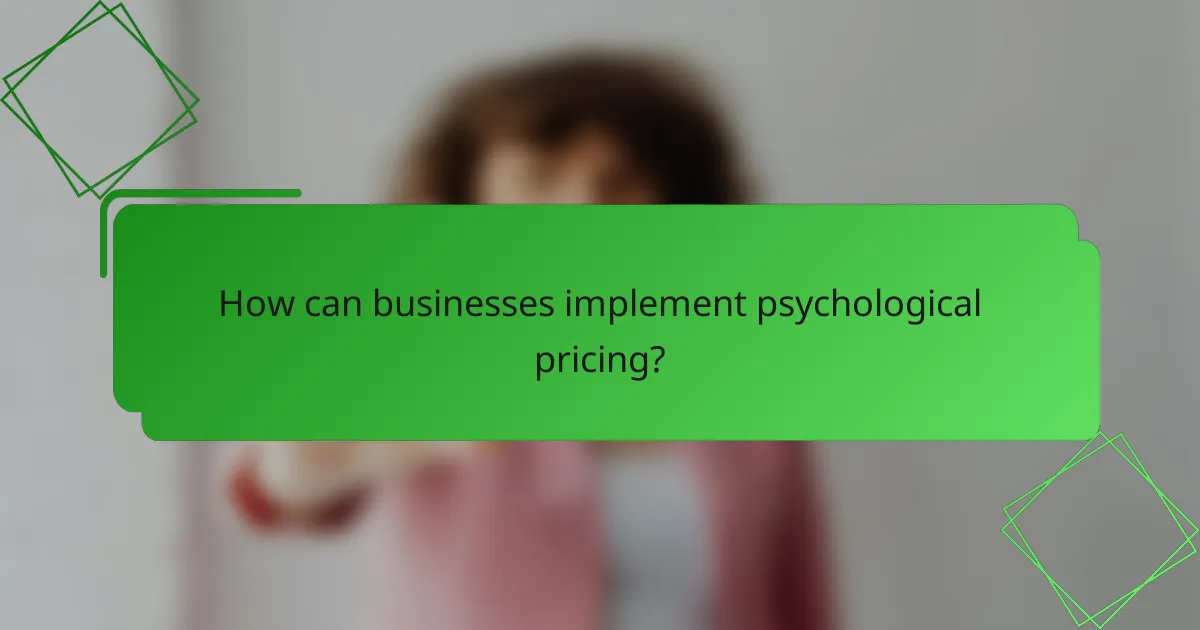Psychological pricing techniques play a crucial role in shaping consumer behavior by influencing how customers perceive value and make purchasing decisions. By leveraging cognitive biases, these strategies create a sense of urgency and enhance product attractiveness, ultimately driving sales and improving revenue for businesses.

How do psychological pricing techniques influence consumer behavior?
Psychological pricing techniques significantly shape consumer behavior by affecting how customers perceive value and make purchasing decisions. These strategies leverage cognitive biases to create a sense of urgency or enhance the attractiveness of a product, ultimately driving sales.
Impact on perceived value
Psychological pricing alters perceived value by presenting prices in a way that seems more appealing. For instance, pricing an item at $19.99 instead of $20.00 can create the illusion of a better deal, making consumers feel they are saving money. This tactic plays on the left-digit effect, where shoppers focus more on the first digit of a price.
Additionally, using tiered pricing can enhance perceived value by offering options that suggest higher quality at a slightly higher price. For example, a software subscription might have three tiers: basic at $9.99, standard at $19.99, and premium at $29.99, leading consumers to perceive the standard option as a better value compared to the basic one.
Effect on purchasing decisions
Psychological pricing can significantly influence purchasing decisions by creating a sense of urgency or exclusivity. Limited-time offers or prices ending in .99 can trigger impulse buying, as consumers may fear missing out on a good deal. This urgency often leads to quicker decision-making, bypassing extensive comparison shopping.
Moreover, anchoring is another powerful technique where the initial price presented serves as a reference point. If a product is initially shown at $100 and then discounted to $75, consumers are more likely to perceive the $75 price as a bargain, thus increasing the likelihood of purchase.
Examples from digital product sales
In the realm of digital products, psychological pricing techniques are widely employed. For instance, many subscription services use monthly pricing models that end in .99, such as $9.99 or $14.99, to enhance perceived affordability. This pricing strategy can make consumers feel they are making a smaller financial commitment.
Another example is the use of free trials followed by a subscription model. A service might offer a free month, after which the price is set at $29.99 monthly. This approach not only lowers the barrier to entry but also capitalizes on the commitment bias, where users are more likely to continue using the service after experiencing it for free.

What are effective psychological pricing strategies for digital products?
Effective psychological pricing strategies for digital products leverage consumer behavior to enhance perceived value and drive sales. Techniques such as charm pricing, price anchoring, and bundle pricing can significantly influence purchasing decisions and improve overall revenue.
Charm pricing
Charm pricing involves setting prices just below a round number, such as $9.99 instead of $10.00. This technique creates a perception of a better deal, as consumers tend to focus on the leftmost digits of a price. For digital products, using charm pricing can lead to increased sales, as it makes the price seem more attractive and affordable.
When implementing charm pricing, consider the psychological impact of the number. Prices ending in .99 are often seen as bargains, while those ending in .00 may be perceived as premium. Test different endings to find what resonates best with your target audience.
Price anchoring
Price anchoring involves presenting a higher-priced item alongside a lower-priced option to influence consumer perception. By establishing a reference point, or anchor, customers are more likely to view the lower price as a good deal. For example, if a digital product is priced at $49.99 alongside a similar product at $99.99, the former appears more appealing.
To effectively use price anchoring, ensure that the anchor product is relevant and comparable. This strategy can be particularly effective in subscription models, where showing a higher tier can make the mid-tier option seem like a better value.
Bundle pricing
Bundle pricing combines multiple products or services into a single package at a reduced price, encouraging consumers to purchase more. This strategy can enhance perceived value and increase overall sales volume. For instance, offering a software suite at a discounted rate compared to purchasing each application separately can drive higher adoption rates.
When creating bundles, ensure that the products complement each other and provide clear benefits. Consider offering tiered bundles to cater to different customer segments, which can help maximize revenue while appealing to a broader audience.

How can businesses implement psychological pricing?
Businesses can implement psychological pricing by strategically setting prices to influence consumer perception and behavior. This approach often involves using pricing techniques that enhance perceived value, thereby increasing sales and customer satisfaction.
Market research techniques
Effective market research is crucial for understanding consumer preferences and price sensitivity. Businesses can utilize surveys, focus groups, and competitor analysis to gather insights on how potential customers perceive value and pricing. This data helps in identifying optimal price points that resonate with target audiences.
Additionally, analyzing demographic factors such as age, income, and location can reveal how different segments respond to various pricing strategies. For instance, younger consumers may be more responsive to promotional pricing, while older demographics might prioritize quality over cost.
Consumer feedback analysis
Collecting and analyzing consumer feedback is essential for refining pricing strategies. Businesses can use online reviews, social media comments, and direct surveys to gauge customer reactions to pricing changes. Understanding customer sentiments can inform adjustments that enhance perceived value.
For example, if feedback indicates that a product is viewed as overpriced, businesses might consider revising the price or enhancing the product’s features to justify the cost. Regularly monitoring feedback allows for timely adjustments to maintain competitive pricing.
Testing pricing models
Testing different pricing models is a practical way to determine what works best for a business. A/B testing can be employed to compare consumer responses to various price points or promotional offers. This method allows businesses to identify which pricing strategies yield the highest conversion rates.
Moreover, businesses should consider seasonal pricing adjustments or limited-time offers to create urgency and boost sales. Keeping track of performance metrics during these tests helps in making data-driven decisions that align with consumer behavior and market trends.

What are the benefits of psychological pricing?
Psychological pricing offers several advantages, including increased sales, enhanced customer loyalty, and improved brand perception. By strategically setting prices that appeal to consumers’ emotions and perceptions, businesses can drive higher conversion rates and foster long-term relationships with their customers.
Increased sales conversion rates
Psychological pricing can significantly boost sales conversion rates by influencing consumer behavior. Techniques such as charm pricing, where prices end in .99 or .95, create a perception of a better deal, prompting more purchases. For example, a product priced at $19.99 may seem more attractive than one at $20, even though the difference is minimal.
Additionally, using tiered pricing strategies can help consumers feel they are getting more value. Offering multiple price points encourages buyers to choose a middle option, which often leads to higher overall sales. Businesses should test different pricing strategies to identify what resonates best with their target audience.
Enhanced customer loyalty
Implementing psychological pricing can foster greater customer loyalty by creating a sense of value and satisfaction. When consumers perceive they are getting a good deal, they are more likely to return for future purchases. Loyalty programs that incorporate psychological pricing, such as discounts or rewards based on spending thresholds, can further strengthen this relationship.
Moreover, consistent pricing strategies that align with consumer expectations can enhance trust. If customers feel they can rely on a brand for fair pricing, they are more likely to become repeat buyers. Businesses should ensure their pricing reflects the perceived value of their products to maintain loyalty.
Improved brand perception
Psychological pricing can enhance brand perception by positioning a product as premium or high-quality. For instance, pricing items slightly higher than competitors can create an impression of exclusivity and superior value. This technique is often used in luxury markets, where consumers associate higher prices with better quality.
Conversely, businesses should be cautious with discounting strategies that may devalue their brand. Frequent sales can lead consumers to question the true worth of a product. Instead, maintaining a balance between perceived value and pricing can help sustain a positive brand image. Companies should regularly assess their pricing strategies to ensure they align with their desired brand perception.

What challenges do businesses face with psychological pricing?
Businesses encounter several challenges when implementing psychological pricing strategies, including consumer skepticism, market competition, and regulatory considerations. These factors can significantly impact the effectiveness of pricing tactics aimed at enhancing perceived value and influencing consumer behavior.
Consumer skepticism
Consumer skepticism arises when customers doubt the authenticity of pricing strategies. Many shoppers are aware of common psychological pricing techniques, such as pricing items at $9.99 instead of $10, leading them to question the true value of the product. This skepticism can diminish the intended impact of psychological pricing, as consumers may perceive these tactics as manipulative.
To combat skepticism, businesses should focus on transparency and value. Clearly communicating the benefits and quality of the product can help build trust and counteract doubts about pricing strategies.
Market competition
In a competitive market, businesses must navigate the pricing strategies of their rivals. If competitors offer similar products at lower prices, psychological pricing may lose its effectiveness. Companies need to ensure that their pricing not only appeals psychologically but also remains competitive within the market landscape.
To address this challenge, businesses can conduct regular market analyses to understand competitor pricing and adjust their strategies accordingly. Offering unique value propositions or bundling products can also help differentiate offerings and justify higher price points.
Regulatory considerations
Regulatory considerations can pose challenges for businesses employing psychological pricing techniques. Certain jurisdictions have laws against deceptive pricing practices, which can include misleading discounts or false claims about product value. Companies must ensure that their pricing strategies comply with local regulations to avoid legal repercussions.
Staying informed about relevant pricing regulations is crucial. Businesses should regularly review their pricing practices and consult legal experts if necessary to ensure compliance while still leveraging psychological pricing effectively.

How does perceived value affect pricing strategies?
Perceived value significantly influences pricing strategies by shaping how consumers view the worth of a product relative to its cost. When customers believe a product offers high value, they are often willing to pay a premium, which can enhance profitability for businesses.
Consumer perception of quality
Consumer perception of quality is closely linked to perceived value, as higher quality often justifies higher prices. Factors such as brand reputation, product features, and customer reviews can elevate this perception. For example, a luxury brand may command higher prices due to its established quality image, even if the actual product features are similar to lower-priced alternatives.
To leverage consumer perception, businesses should focus on enhancing the quality signals associated with their products. This can include investing in better materials, offering warranties, or showcasing certifications. A well-designed marketing campaign that highlights these quality aspects can significantly boost perceived value.
Common pitfalls include neglecting customer feedback and failing to maintain consistent quality. Businesses should regularly assess consumer perceptions through surveys and reviews to ensure they align with their pricing strategies. This proactive approach helps avoid discrepancies that could harm brand reputation and sales.


